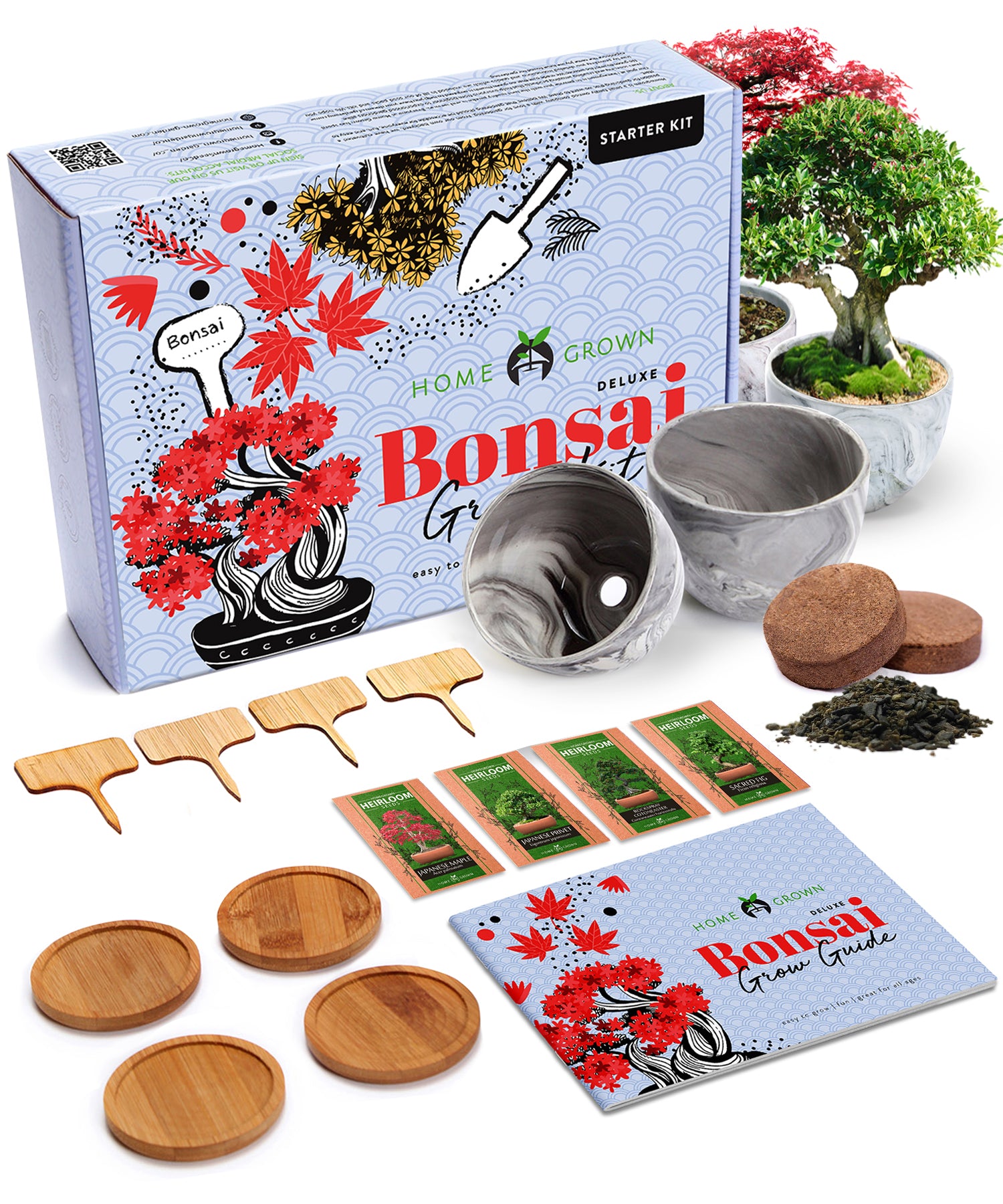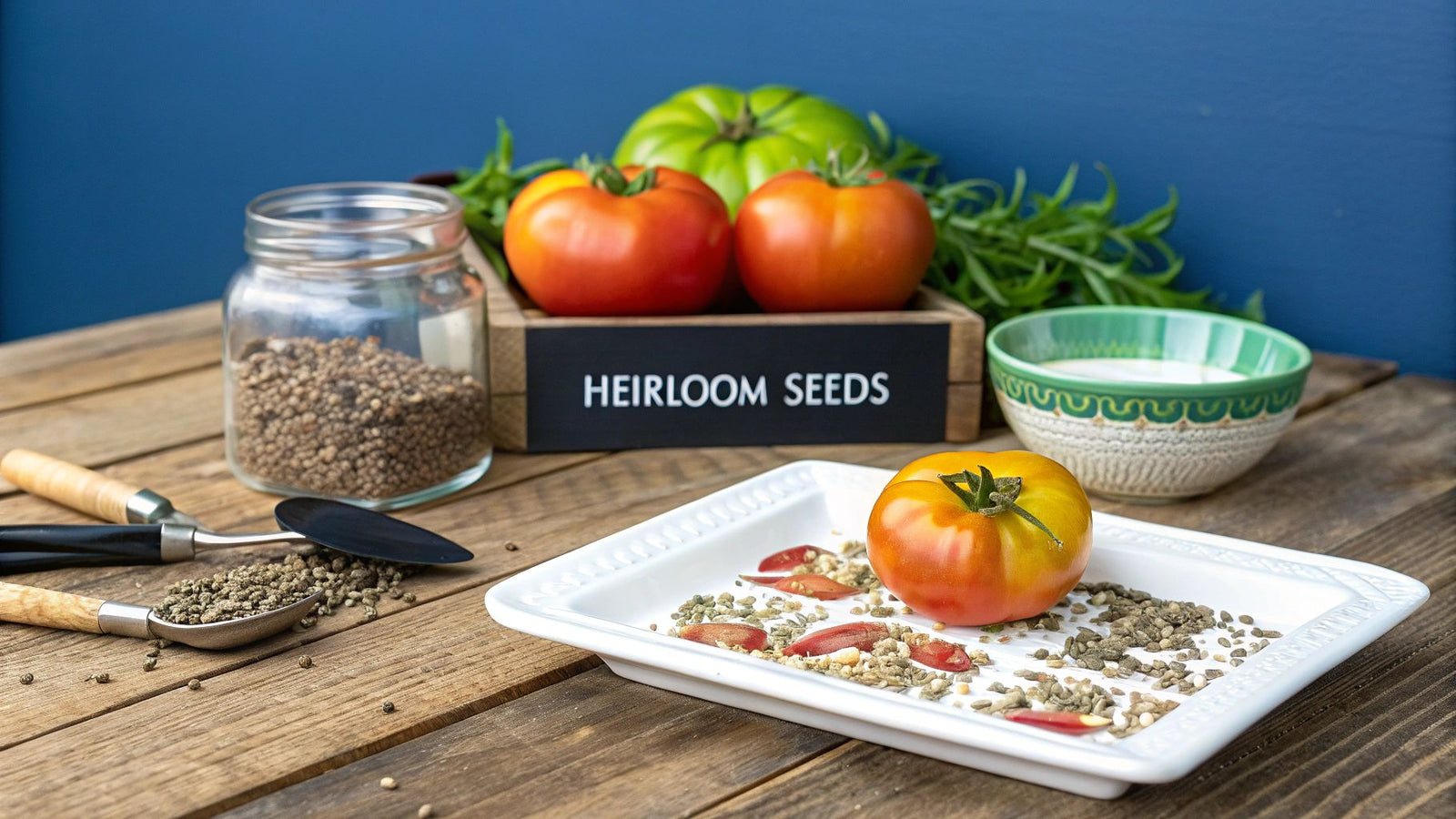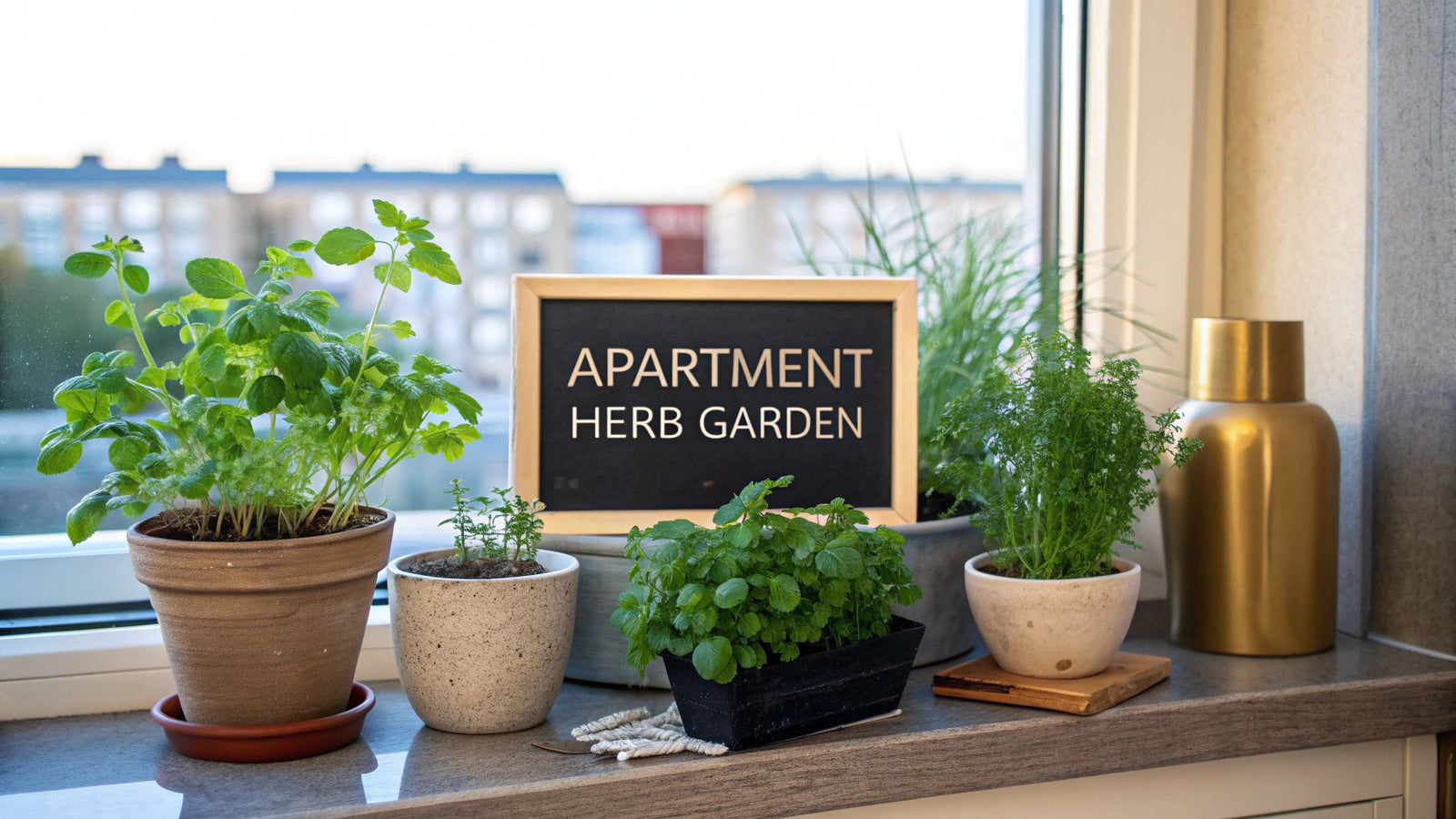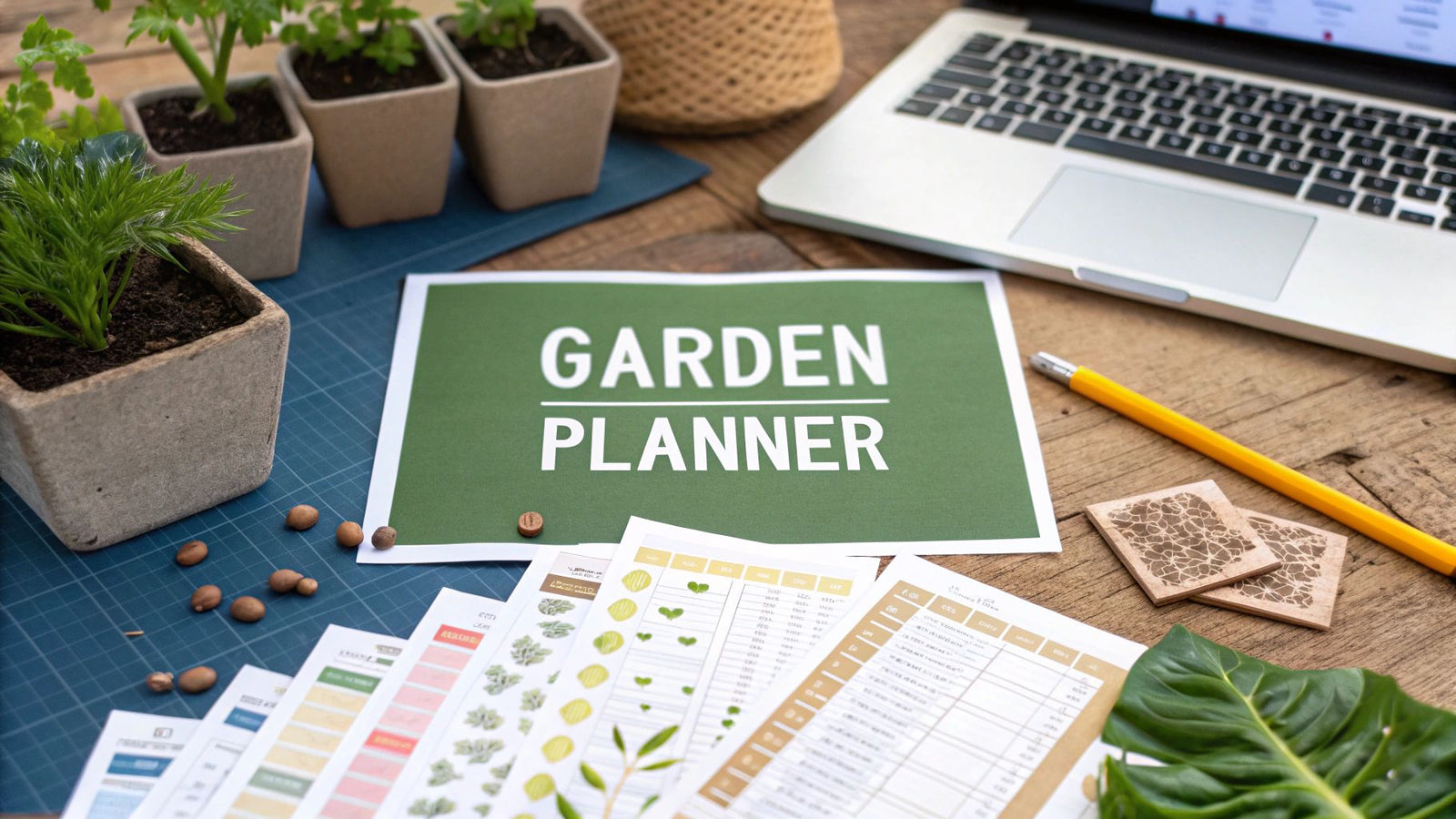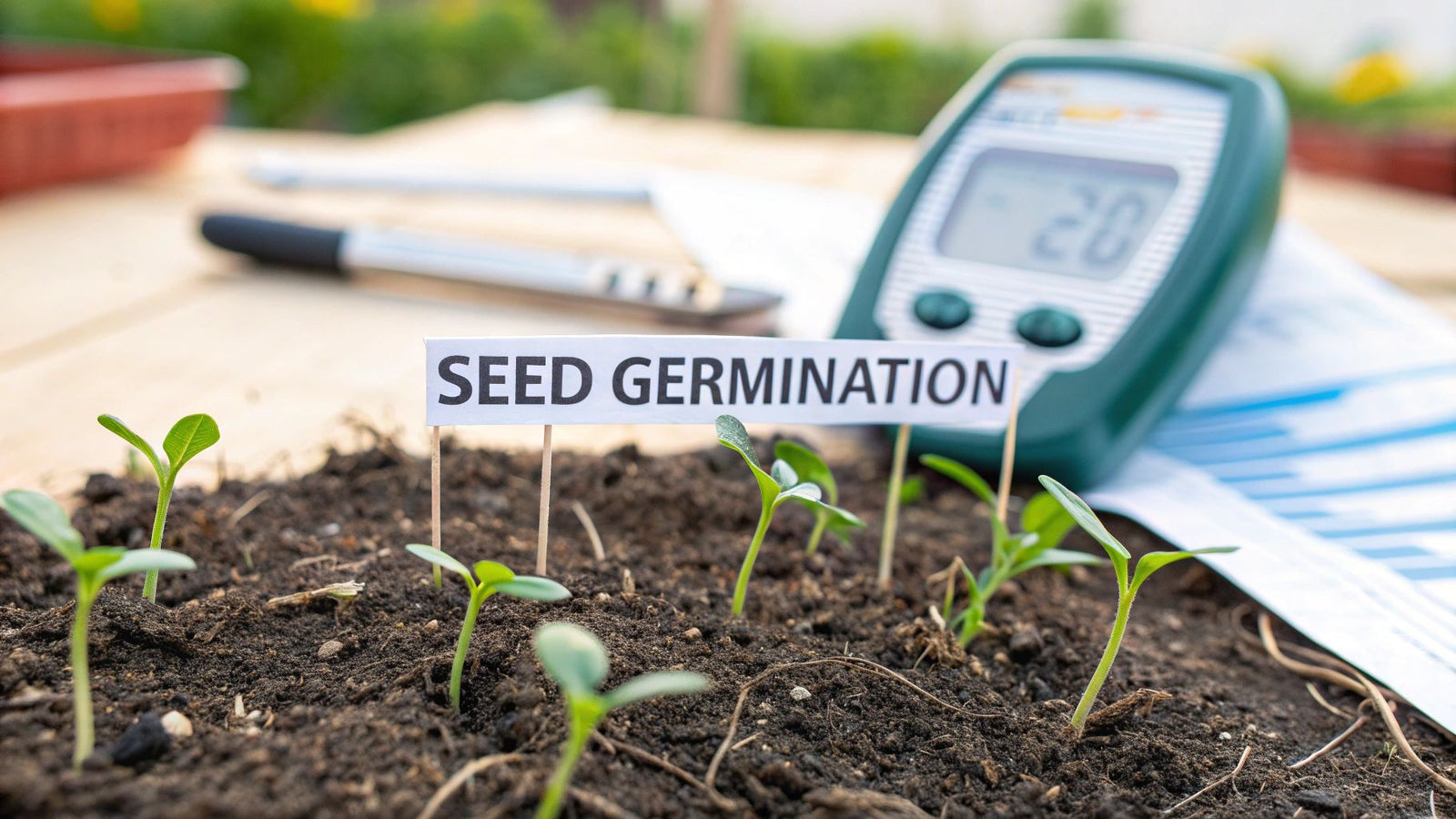
A seed germination temperature chart is one of the most valuable tools in a gardener's arsenal. It's a straightforward reference that outlines the ideal soil temperatures needed for various seeds—vegetables, flowers, and herbs—to sprout successfully. Think of it as a cheat sheet for faster, more reliable germination, giving you the optimal range, as well as the absolute minimum and maximum temperatures a seed can handle.
Why Soil Temperature Is the Real Secret to Germination
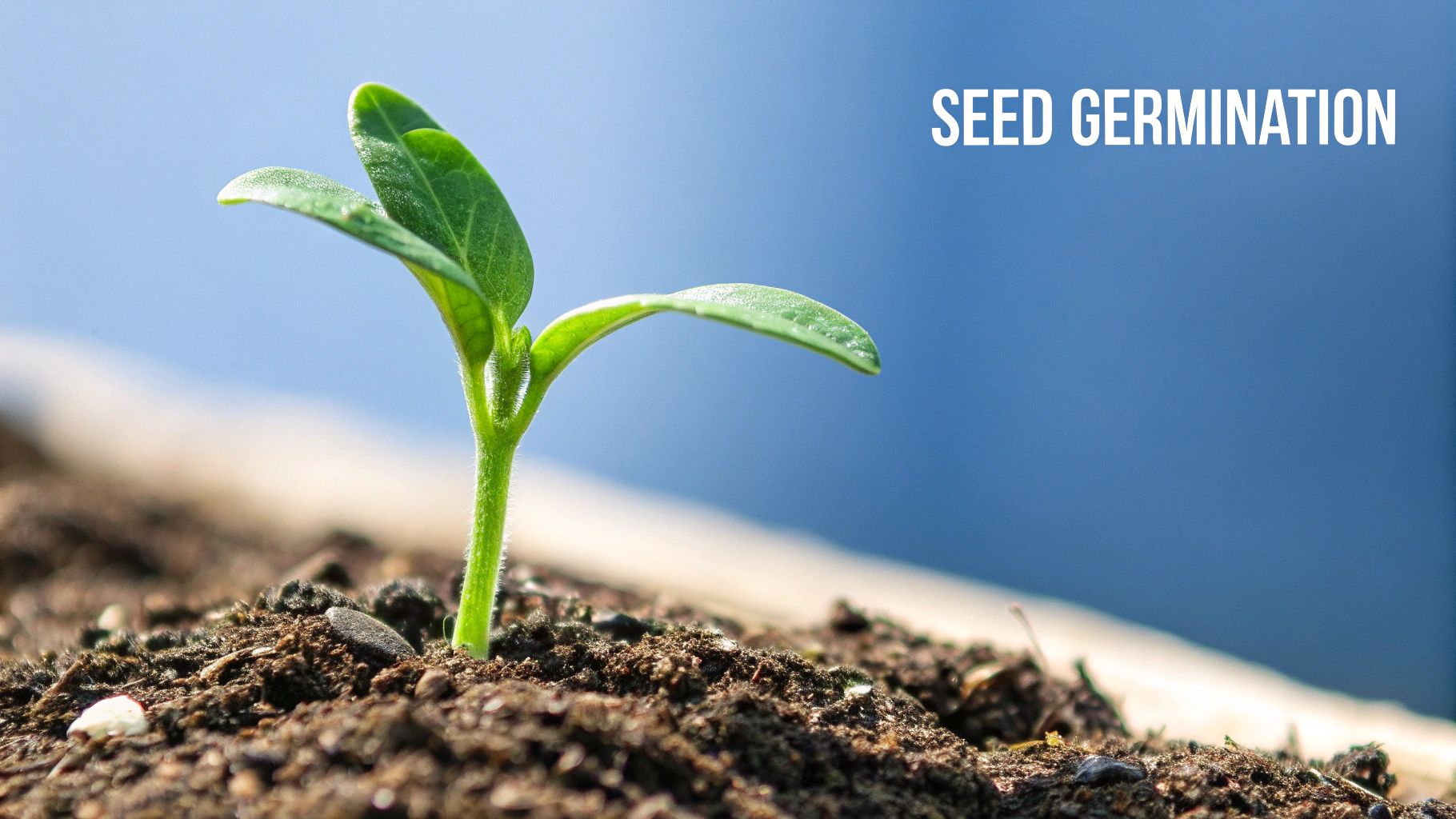
It’s easy to get caught up tracking air temperature, but what’s happening underground is what truly matters for a sprouting seed. Soil temperature is the single most important signal that tells a seed it's time to wake up and start growing.
Every seed is essentially a self-contained life-support system, waiting patiently in a dormant state. To break this dormancy and kick off the germination process, it needs the right environmental cues. While moisture and oxygen are definitely part of the equation, temperature is the primary trigger that starts the seed's internal engine.
The Science of Sprouting
Picture a seed as a tiny, sleeping factory. The right temperature flips the "on" switch, setting off a chain reaction of biological events.
- Enzyme Activation: The enzymes inside a seed are highly sensitive to temperature. Once the soil warms up to that sweet spot, these enzymes get to work, breaking down stored starches into simple sugars. This is the fuel the embryo needs to grow.
- Metabolic Rate: Just like us, a seed's metabolism speeds up with warmth. Warmer soil accelerates the chemical reactions required for cell division and expansion, leading to much faster and more vigorous sprouting.
- Breaking Dormancy: For many seeds, a specific temperature range is a natural signal that winter is over and conditions are right for the new seedling to survive and thrive.
Gardener’s Insight: From my experience, inconsistent or incorrect soil temperature is the number one reason for germination failure. If it's too cold and wet, seeds often rot before they even have a chance. If it's too hot, they can be "cooked" into a permanent state of dormancy.
Optimal vs. Minimum and Maximum Temperatures
A good seed germination temperature chart will give you three crucial numbers. The optimal range is your target—it's where you'll get the fastest, most consistent results. For a lot of common garden vegetables, extensive research points to a sweet spot around 20-25°C (68-77°F). You can dig deeper into temperature's role in germination to see just how critical it is.
The minimum temperature, on the other hand, is the absolute coldest a seed might sprout, but expect it to be a very slow and sluggish process. The maximum temperature is the tipping point where the heat becomes damaging and can kill the seed. Knowing these limits is truly fundamental to getting your garden off to a strong start.
Getting the Most from the Seed Temperature Charts
Think of these charts as your secret weapon for successful seed starting. They're built to be a quick reference, giving you the exact soil temperatures you need to get seeds to sprout reliably. But to really put this information to work, it helps to know exactly what you're looking at.
Consider this your roadmap for germination. Each row provides the critical data points to give your seeds the best possible start, whether you're sowing them in trays indoors or directly into your garden beds. If you want to explore the science behind it all, be sure to read our complete guide on mastering the art of seed germination at home.
Making Sense of the Columns
Using the charts is simple. Just find the plant you're planning to grow in the first column, then read across to see what it needs to thrive.
Here’s a quick breakdown of what each term means:
- Optimal Range: This is the temperature sweet spot. If you can keep your soil consistently within this window, you'll see the fastest and highest germination rates. It's the ideal target.
- Minimum/Maximum Temp: These are the absolute outer limits. Seeds might sprout at the minimum temperature, but it will be incredibly slow and spotty. Go past the maximum, and you risk cooking your seeds before they even have a chance.
- Days to Germination: This number gives you a solid estimate of how long you'll wait for seedlings to pop up, assuming you've hit that optimal temperature range.
Putting This Knowledge Into Practice
This data is only as good as your measurements. That's why a simple soil thermometer is one of a gardener's best friends. Before you plant a single seed, poke the thermometer into your seed-starting mix or garden soil to get an accurate reading.
For instance, you might be eager to start tomatoes indoors. A quick temperature check will tell you if your soil is hitting that ideal 75-85°F (24-29°C) range. If it’s not, you’ll know a seedling heat mat is probably necessary to get the job done right.
Gardener’s Tip: Never just guess your soil temperature based on the air temperature. A warm, sunny day might heat the very top layer of soil, but just a half-inch down—right where your seeds are—it can be significantly colder. Always measure at the actual planting depth.
Vegetable Seed Germination Temperature Chart
This is the heart of the guide—the section you’ll return to again and again. Think of this as your master reference for giving every seed the perfect start. The chart below is organized alphabetically, making it easy to find exactly what you're looking for in seconds.
Inside, you'll find the optimal soil temperature range for the best germination rates, the absolute rock-bottom minimum and sky-high maximum temperatures a seed can tolerate, and how many days it typically takes to see that first sprout. I've also added a "Gardener's Notes" column, which is packed with little tips and tricks I've learned over the years. This isn't just data; it's a practical roadmap to success.
Why Temperature Matters So Much
The link between soil temperature and germination is incredibly direct. As you can see in the infographic, getting into that "sweet spot" temperature-wise can make all the difference, often pushing germination rates to 90% or higher.
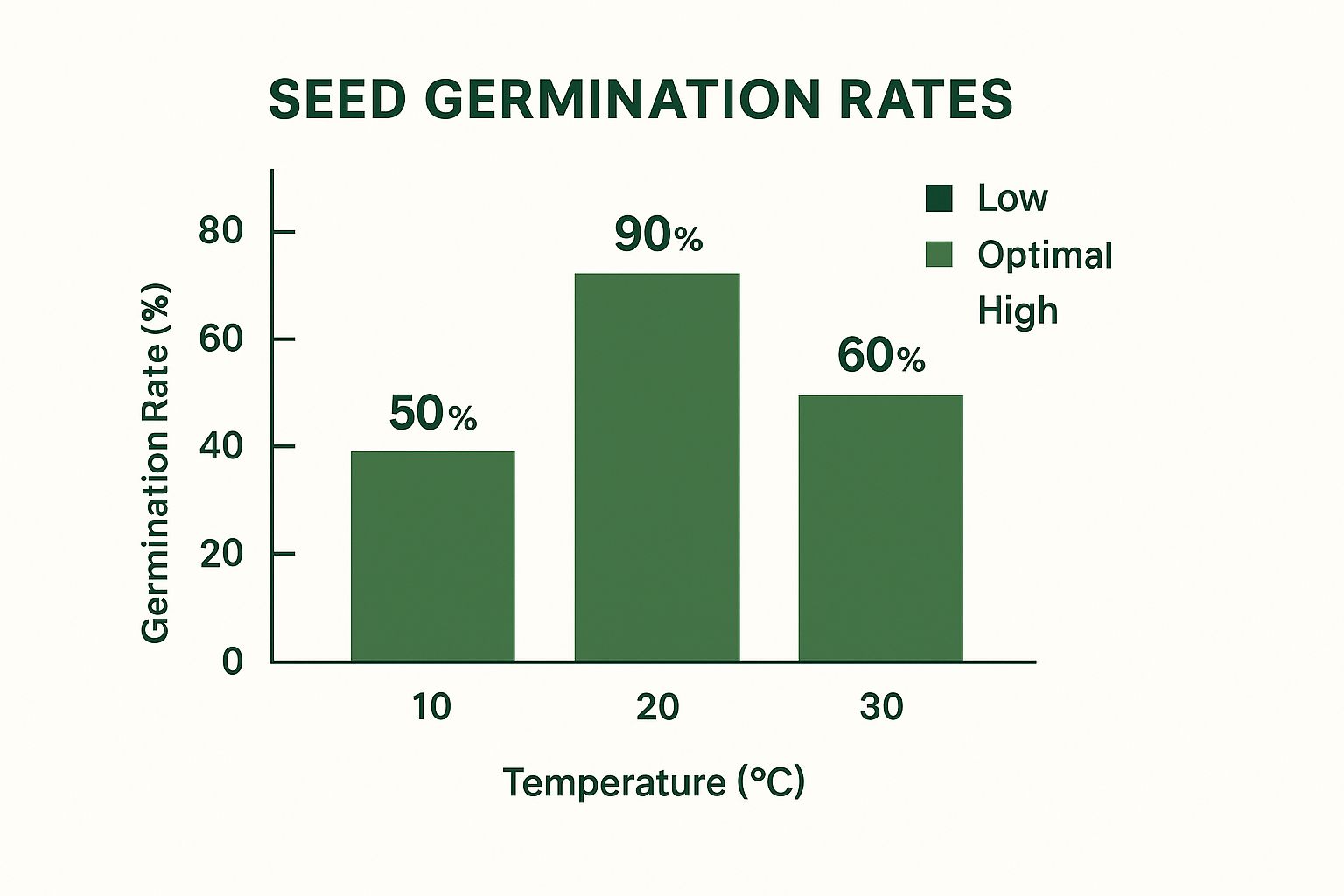
This simple visual says it all. While a few seeds might pop up in soil that's a bit too cool or too warm, you'll get the most reliable, uniform, and successful results by sticking to that ideal window. Straying too far from it is a recipe for slow growth, patchy germination, or even complete failure.
Vegetable Seed Germination Temperatures and Times
Here it is—your go-to reference for getting your seeds started right. Use this chart to check the soil temperature before you plant, whether you're starting seeds inside on a heat mat or sowing them directly into the garden beds. Matching your conditions to the optimal ranges listed here is the single best thing you can do for your seeds.
| Vegetable | Optimal Soil Temp (°F) | Optimal Soil Temp (°C) | Min/Max Temp (°F) | Days to Germination |
|---|---|---|---|---|
| Asparagus | 75-85°F | 24-29°C | 60-95°F | 10-14 |
| Beans | 75-85°F | 24-29°C | 60-95°F | 7-14 |
| Beets | 65-75°F | 18-24°C | 40-95°F | 5-10 |
| Broccoli | 75-85°F | 24-29°C | 40-95°F | 7-10 |
| Cabbage | 75-85°F | 24-29°C | 40-95°F | 7-10 |
| Carrots | 65-85°F | 18-29°C | 40-95°F | 10-21 |
| Cauliflower | 75-85°F | 24-29°C | 40-95°F | 7-10 |
| Celery | 60-70°F | 16-21°C | 50-85°F | 14-21 |
| Corn | 75-95°F | 24-35°C | 55-105°F | 7-10 |
| Cucumber | 75-95°F | 24-35°C | 60-105°F | 7-10 |
| Eggplant | 80-90°F | 27-32°C | 60-95°F | 7-14 |
| Kale | 65-85°F | 18-29°C | 40-95°F | 5-10 |
| Lettuce | 60-70°F | 16-21°C | 35-85°F | 7-10 |
| Onions | 65-85°F | 18-29°C | 35-95°F | 7-10 |
| Peas | 60-75°F | 16-24°C | 40-85°F | 7-14 |
| Peppers | 80-90°F | 27-32°C | 60-95°F | 7-14 |
| Pumpkin | 85-95°F | 29-35°C | 60-105°F | 7-10 |
| Radish | 65-85°F | 18-29°C | 40-95°F | 3-7 |
| Spinach | 50-70°F | 10-21°C | 35-75°F | 7-14 |
| Squash | 85-95°F | 29-35°C | 60-105°F | 7-10 |
| Swiss Chard | 65-75°F | 18-24°C | 40-95°F | 7-10 |
| Tomatoes | 75-85°F | 24-29°C | 50-95°F | 5-10 |
| Turnips | 65-85°F | 18-29°C | 40-105°F | 5-10 |
| Watermelon | 85-95°F | 29-35°C | 60-105°F | 5-10 |
| Zucchini | 85-95°F | 29-35°C | 60-105°F | 7-10 |
Remember, these are guidelines, not unbreakable laws. A few degrees off won't spell disaster, but the closer you get to these optimal temperatures, the faster and more reliable your germination will be. Happy planting
Flower and Herb Seed Germination Temperature Chart
Vegetables might be the workhorses of the garden, but it’s the flowers and herbs that bring it to life with color and scent. Just like vegetables, though, these plants have very specific soil temperatures they need to get off to a good start. This seed germination temperature chart is dedicated to your favorite annuals, perennials, and kitchen herbs.
It often surprises gardeners to learn that some of the most stunning flowers, like sweet peas, actually demand cool soil to sprout. A common mistake is treating every seed the same. Applying heat to a cool-loving flower won't just fail to help—it can stop germination in its tracks.
Understanding Special Requirements
Flowers and herbs often come with their own unique germination quirks that go beyond just temperature. This is where reading the seed packet—and our chart below—really pays off.
For instance, some seeds absolutely need light to germinate and should only be pressed lightly onto the soil's surface, never buried. Others, especially certain perennials, won’t break dormancy without a period of cold, moist conditions, a process we call stratification. It’s basically a way to trick the seed into thinking it has survived a winter.
- Light-Dependent Germinators: Seeds like poppies and dill need a direct cue from the sun. If you cover them with even a fine layer of soil, they may never get the message to sprout.
- Cold Stratification: Lavender and milkweed are prime examples. They germinate far more reliably after spending a few weeks in a "false winter" inside your refrigerator before you plant them.
Gardener’s Tip: Don't just throw all your seed trays on a heat mat by default. While your heat-loving zinnias will pop right up, you could be killing your sweet peas, which sprout best when the soil is a brisk 50-55°F (10-13°C). Always check the individual needs of what you're growing.
Flower and Herb Germination Temperatures
Use this chart as your go-to reference for creating the perfect environment for your flower and herb seeds. It'll help you get the soil temperature just right, whether you're starting seeds indoors or sowing them straight into the garden. Pay close attention to the "Gardener's Notes" column for those crucial tips that make all the difference with trickier seeds.
| Flower / Herb | Optimal Soil Temp (°F) | Optimal Soil Temp (°C) | Min/Max Temp (°F) | Days to Germination | Gardener's Notes |
|---|---|---|---|---|---|
| Ageratum | 70-75°F | 21-24°C | 65-80°F | 5-10 | Needs light to germinate; press into soil surface. |
| Basil | 70-75°F | 21-24°C | 60-85°F | 5-10 | Requires consistent warmth. |
| Calendula | 60-70°F | 16-21°C | 50-80°F | 7-14 | Prefers cooler soil. |
| Chamomile | 65°F | 18°C | 55-75°F | 10-14 | Needs light to germinate; do not cover. |
| Chives | 60-70°F | 16-21°C | 50-85°F | 10-14 | Can be slow to start; be patient. |
| Cilantro/Coriander | 55-65°F | 13-18°C | 50-75°F | 7-14 | Dislikes heat; direct sow for best results. |
| Cosmos | 70-75°F | 21-24°C | 65-85°F | 7-14 | Easy to grow; tolerates poorer soil. |
| Dill | 60-70°F | 16-21°C | 50-80°F | 10-21 | Needs light; lightly cover seed. |
| Lavender | 65-70°F | 18-21°C | 60-75°F | 14-28 | Benefits from cold stratification for 4-6 weeks. |
| Marigold | 70-80°F | 21-27°C | 65-85°F | 5-7 | Very fast and easy to germinate with warmth. |
| Mint | 70-75°F | 21-24°C | 65-80°F | 10-16 | Germination can be erratic. |
| Oregano | 65-75°F | 18-24°C | 60-85°F | 10-21 | Tiny seeds; needs light to germinate. |
| Parsley | 60-70°F | 16-21°C | 50-80°F | 14-28 | Notoriously slow; soak seeds overnight. |
| Poppy | 55-60°F | 13-16°C | 45-65°F | 10-20 | Requires light and cool soil; direct sow. |
| Rosemary | 60-70°F | 16-21°C | 55-80°F | 14-28 | Very slow and difficult from seed; cuttings are easier. |
| Sage | 60-70°F | 16-21°C | 55-80°F | 14-21 | Keep soil evenly moist. |
| Sunflower | 70-85°F | 21-29°C | 60-90°F | 7-14 | Plant directly in the garden after frost. |
| Sweet Pea | 50-55°F | 10-13°C | 40-65°F | 10-14 | Must have cool soil; do not use a heat mat. |
| Thyme | 65-70°F | 18-21°C | 60-75°F | 14-28 | Needs light; germination can be slow. |
| Zinnia | 75-80°F | 24-27°C | 70-85°F | 5-7 | Loves heat and germinates quickly. |
Essential Tools for Managing Soil Temperature
Having a good seed germination temperature chart is one thing, but actually hitting those target temperatures is where the real work begins. To translate that data into successful sprouts, you'll need a few key pieces of equipment for measuring and adjusting your soil's warmth. These tools give you the control needed for consistent germination.
Your most indispensable tool is a quality soil thermometer. This isn't the same as the one hanging outside your window; it’s specifically designed to be pushed directly into the soil or growing medium to get a precise reading right where the seed is. You can find digital models for a quick, easy-to-read number or opt for a classic analog thermometer, which is incredibly durable and never needs batteries.
For anyone starting seeds inside, a seedling heat mat can feel like a secret weapon. These mats sit under your seed trays and provide steady, gentle bottom heat. This is especially critical for heat-loving plants like peppers and tomatoes that need soil temperatures consistently in the 80-90°F (27-32°C) range to sprout reliably. A heat mat keeps the soil cozy day and night, eliminating temperature swings. For more on this, don't miss our tips for starting seeds indoors.
Tools for Outdoor Temperature Control
Managing soil temperature isn't just an indoor game. When you're gardening outside, several simple tools can help you work with—or even change—the conditions in your garden beds.
-
Cold Frames and Low Tunnels: Think of these as miniature greenhouses. By trapping the sun's energy, these structures warm the air and, more importantly, the soil beneath them. They're fantastic for getting a jump on spring planting for cool-season crops or for extending your harvest season later into the fall.
-
Mulches: The right mulch can dramatically influence soil temperature. A layer of black plastic mulch, for example, is a classic trick for absorbing solar radiation and significantly warming the soil for crops like melons and squash. On the other hand, a thick blanket of organic mulch like straw or shredded leaves will insulate the soil, keeping it cooler and moist for plants like lettuce that bolt in the summer heat.
Troubleshooting Common Germination Problems
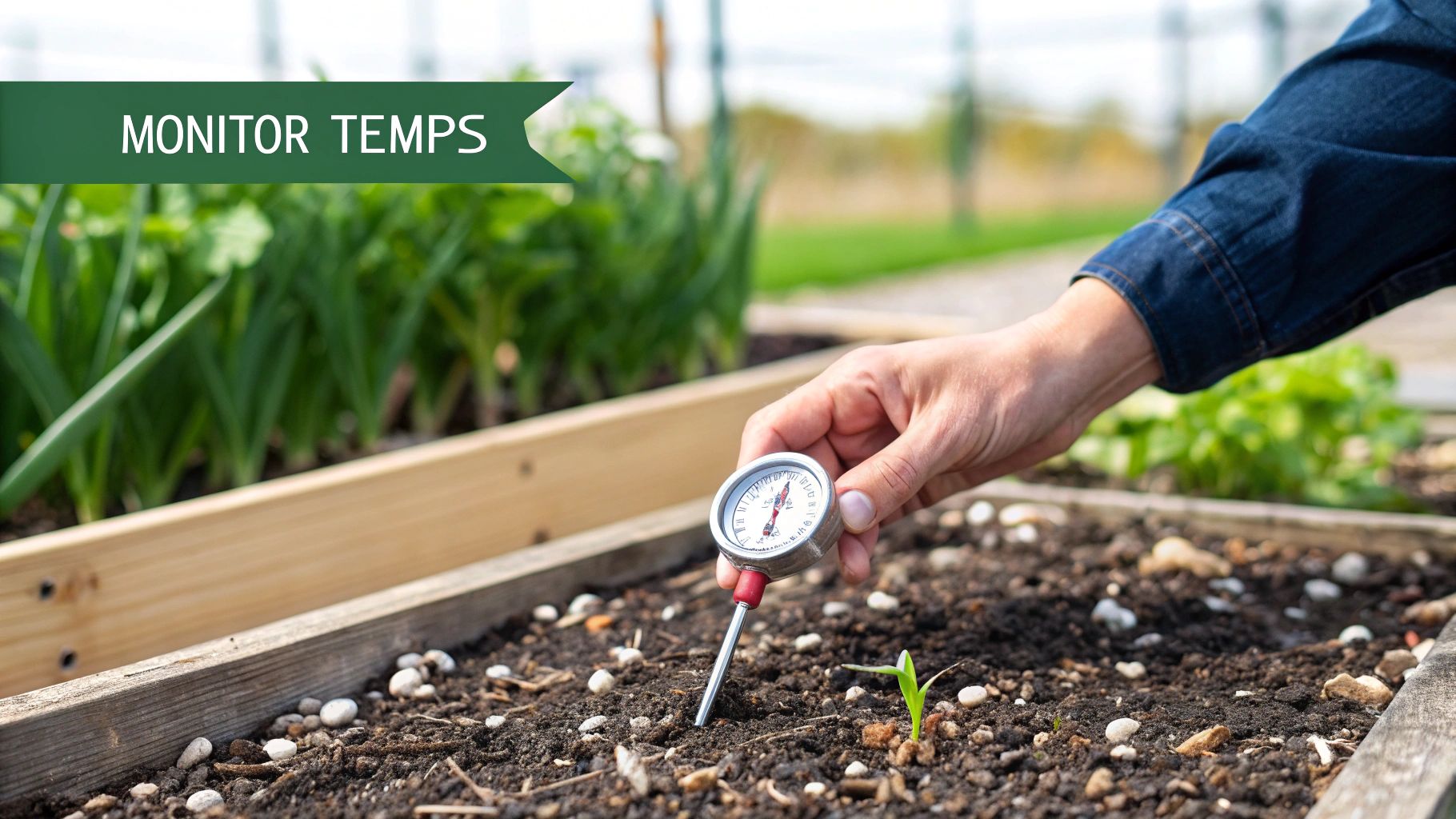
Even after carefully following a seed germination temperature chart, you might find yourself staring at a tray of soil with no signs of life. It’s a frustrating moment for any gardener, but don't give up just yet. More often than not, the reason for the no-show is one of a few common and fixable issues.
The first thing to check is almost always the soil temperature. If it's too cold, your seeds might just sit there, dormant, or worse, rot away before they even get started. On the flip side, soil that's too hot can literally cook the life out of a seed, pushing it into permanent dormancy.
Solving Temperature and Moisture Issues
Wild swings in temperature can be just as bad as consistently being too hot or too cold. A warm, sunny day that gives way to a frigid night can confuse a seed and bring the germination process to a grinding halt. Stability is your friend here, especially for finicky, heat-loving plants like peppers and eggplants. This is exactly why many of us rely on a seedling heat mat to provide that steady, gentle warmth they need.
Water is the other half of the equation, and getting it right is a delicate balance. You're aiming for soil that feels like a well-wrung-out sponge—consistently moist but never soggy.
- Too Wet: When soil is saturated, there's no room for oxygen, which seeds absolutely need to "breathe" and sprout. Waterlogged conditions are also a perfect invitation for fungal diseases like "damping off," which rots the tender stems right at the soil line.
- Too Dry: A seed might start the germination process, but if the soil dries out completely, that new life will wither and die. This is a particularly common problem for tiny seeds that are sown very close to the surface.
Expert Insight: I see a lot of gardeners struggle with sweet peas, and the culprit is almost always too much warmth. People assume they need heat, but sweet peas are different. They prefer cool soil, germinating best around 50-55°F (10-13°C). Putting them on a heat mat is one of the surest ways to stop them from ever sprouting.
Diagnosing Other Common Problems
So, your temperature is stable and your moisture level seems perfect, but you've still got nothing? It's time to look at a few other potential culprits.
Incorrect Planting Depth
The classic rule of thumb is to plant a seed about twice as deep as its width. If you go too deep, the poor seedling can exhaust all its stored energy just trying to break through to the surface for that first taste of light. And some seeds, like dill, lettuce, or poppies, actually need light to germinate, so they should barely be covered with soil at all.
Old or Non-Viable Seeds
Seeds don't last forever. Their viability, or ability to sprout, drops with each passing year. If you're working with a packet of seeds from a few seasons ago, don't be surprised if your germination rate is lower than expected. It's always a good habit to check the "packed for" date on the packet.
If you're looking to sidestep these issues from the get-go, our guide on 10 tips for successful sowing and germination is packed with more preventative advice. By running through this mental checklist, you can diagnose the problem and turn those disappointing trays into a thriving collection of seedlings.
Your Top Germination Questions, Answered
Even with the best charts in hand, starting seeds can sometimes feel like a bit of a mystery. Let's tackle some of the most common questions that pop up when you're trying to get those seeds to sprout.
What Happens If My Soil Is Too Hot or Too Cold?
Think of temperature as the starting gun for a race. If the soil is too cold, your seeds will simply stay dormant, waiting for warmer, more favorable conditions to arrive. The real danger here is that cold, wet soil is the perfect breeding ground for fungus and rot, which can destroy the seeds before they ever get a chance to wake up.
On the flip side, soil that's too hot can be just as deadly. Extreme heat can scorch the delicate seed, essentially cooking it before it can grow. In some cases, it can even trick the seed into entering a permanent state of dormancy, from which it will never emerge. Every seed variety has its "sweet spot," and getting too far outside that range is a recipe for failure.
Can I Just Use a Regular Thermometer for the Soil?
You could, but you'd be guessing. A standard weather thermometer only tells you the air temperature, which can be wildly different from the temperature a couple of inches down in your seed tray.
A proper soil thermometer is a game-changer. It has a long, sturdy probe designed to be pushed right down to planting depth. This gives you an accurate picture of the actual environment your seeds are in, taking the guesswork out of the equation.
Why Didn't My Seeds from a Global Database Sprout?
It's incredible what modern science has done for horticulture. Projects like the SeedArc initiative, which kicked off in 2023, are gathering immense amounts of data on germination rates and optimal temperatures from all over the planet. You can learn more about these amazing global seed research efforts to see just how sophisticated this field has become.
But here’s the thing: those databases report results from perfect, controlled lab settings. Your garden or seed-starting station is a different beast entirely. Your unique soil composition, moisture levels, light exposure, and planting depth all have a huge impact.
More than anything, though, the problem might be the seed itself. Old, poorly stored, or low-quality seeds often have poor viability and won't sprout no matter what you do. For the best chance of success, always start with fresh, high-quality seeds from a trusted source.
Ready to put this knowledge into practice? Homegrown Garden offers a wide selection of high-quality, heirloom seeds guaranteed to give you the best start. Explore our collection of vegetable, flower, and herb seeds today at https://www.homegrown-garden.com.

